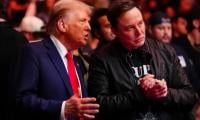New power structures
On February 5, US President Donald Trump finally delivered his State of the Union speech to a packed house in Congress. The speech had been delayed by a week since Nancy Pelosi, the speaker of the US House of Representatives, had disinvited Trump due to the government shutdown that he had instigated.
In doing so, Pelosi also delivered a message that the US president isn’t used to hearing: Congress was a coequal branch of government under the US constitution and doesn’t have to take orders from the president.
The last two years since Donald Trump was elected president have been quite a journey for the US public and indeed the world. Trump has turned out to be just the unorthodox president that he had promised to be. What wasn’t expected was that he would go on to insult friends and allies alike, and show total disregard for basic principles of avoiding conflicts of interest.
“The president cannot have a conflict of interest,” he told the press before taking office. Turns out, US law doesn’t require a president to not have such conflicts in conducting national business. So, a president, if he/she so chooses, can make decisions and conduct national affairs in a manner that personally benefit him/her, without breaking any law.
One can only wonder how long we have to wait before new laws are enacted that forbid such behaviour. In a sense, Trump has done a real service to the country by showing the loopholes that exist in the current legal structure that could jeopardise the interests of the country.
On January 2, a new Congress was sworn-in giving the majority in the House of Representatives to the Democratic Party. For the first time since he began his tenure, Trump is faced with a real opposition that has powers to scrutinise his decisions and actions. Among other things, the House of Representatives is now trying to obtain copies of the president’s tax returns from past years so they can find out if his decisions are somehow personally benefitting him financially.
The next US presidential elections are almost two years away, even though campaigns are starting to ramp up already. After all, the US presidential elections cost over $2 billion. All indications are that the Democratic Party may have upwards of 20 candidates running for president.
As much as this looks like a very crowded field – which it is – one can be reminded that in the last presidential election, the Republican Party had 17 candidates to begin with. The fight may go on till early or mid-2020 before one opponent emerges to face Donald Trump in November. Needless to say the next year or more in US politics is likely to be full of drama.
While all this politicking goes on, neither the business of the government nor the crises of the world will stop. The US president is already looking to end American engagement in Syria and conclude a quick truce with the Afghan Taliban. It is difficult to assess the full extent to which these foreign-policy decisions would be impacted by domestic political considerations.
These are very high-stakes decisions that the US government will make, which may impact the lives of millions in these regions. The world has yet to recover from the decisions that the US government made a decade or more ago. One can only hope that in the midst of domestic political turmoil, the Trump administration will somehow have the wisdom to make decisions that at least don’t make matters worse.
The writer is a Pakistani-American based inWashington D C. He is the author of ‘When Tribesmen Came Calling: Building an Enduring AmericanBusiness in Pakistan.
Website: www.sqshareef.com/ blogs
-
 Philippines Blocks Elon Musk’s Grok AI
Philippines Blocks Elon Musk’s Grok AI -
 Jennifer Lawrence Blames Internet For Losing Sharon Tate Role
Jennifer Lawrence Blames Internet For Losing Sharon Tate Role -
 DeepMind, Google CEOs Sync Daily To Accelerate AI Race Against OpenAI
DeepMind, Google CEOs Sync Daily To Accelerate AI Race Against OpenAI -
 Japan Launches Probe Into 'Grok AI' Following Global Scrutiny Over 'inappropriate' Content
Japan Launches Probe Into 'Grok AI' Following Global Scrutiny Over 'inappropriate' Content -
 Prince Harry All Set To Return To Britain Next Week?
Prince Harry All Set To Return To Britain Next Week? -
 Is Princess Charlotte Becoming Most Confident Young Royal?
Is Princess Charlotte Becoming Most Confident Young Royal? -
 ‘Stranger Things’ Star David Harbour Speaks Up About ‘psychotherapy’
‘Stranger Things’ Star David Harbour Speaks Up About ‘psychotherapy’ -
 Jennifer Love Hewitt Talks About Scary 9-1-1 Episode
Jennifer Love Hewitt Talks About Scary 9-1-1 Episode -
 Kate Middleton Ditches Palace Life For Where She 'truly Relaxes'
Kate Middleton Ditches Palace Life For Where She 'truly Relaxes' -
 Pixel Watch May Soon Warn You If You Leave It Behind
Pixel Watch May Soon Warn You If You Leave It Behind -
 Serious Liver Scarring Shows Potential To Be Reversed With Latest Drug
Serious Liver Scarring Shows Potential To Be Reversed With Latest Drug -
 Elon Musk Backs Donald Trump To Invoke Insurrection Act Amid Minnesota Protests
Elon Musk Backs Donald Trump To Invoke Insurrection Act Amid Minnesota Protests -
 Scientists Unravel Mystery Of James Webb’s ‘little Red Dots’ In Deep Space
Scientists Unravel Mystery Of James Webb’s ‘little Red Dots’ In Deep Space -
 Nano Banana Explained: How Google’s AI Got Its Name
Nano Banana Explained: How Google’s AI Got Its Name -
 Fire Causes Power Outage On Tokyo Train Lines, Thousands Stranded As ‘operations Halted’
Fire Causes Power Outage On Tokyo Train Lines, Thousands Stranded As ‘operations Halted’ -
 YouTube, BBC To Ink Landmark Deal To Launch Exclusive Bespoke Shows
YouTube, BBC To Ink Landmark Deal To Launch Exclusive Bespoke Shows



